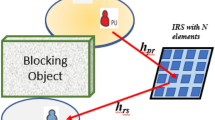Abstract
In this paper, a novel multiple-user cooperative spectrum sensing (MCSS) scheme is proposed to achieve the spatial diversity gains for cognitive radio (CR) networks, where only the best relay, selected among all the candidate relays in accordance with the quality of channel conditions, is utilized to cooperatively detect the primary user. Closed-form expressions of detection time for the traditional non-cooperative and the proposed MCSS schemes are derived over Rayleigh fading channels. In addition, numerical experimentations are conducted to make a performance comparison between the non-cooperative sensing and our scheme. The result shows that by exploiting the multiple-user cooperation, the detection time is reduced greatly and moreover, diversity gains obtained by the MCSS scheme increase with a rise in the number of candidate relays.
Similar content being viewed by others
References
Haykin S. Cognitive radio: brain-empowered wireless communications. IEEE JSAC, 2005, 23(2): 201–220
Ghozzi M, Dohler M, Marx F, et al. Cognitive radio: Methods for the detection of free band. CR Phys Elsevier, 2006, 7: 794–804
Akyildiz I F, Lee W Y, Vuran M C, et al. Next generation/dynamic spectrum access/cognitive radio wireless networks: A survey. Comput Netw, 2006, 50: 2127–2159
Sahai A, Hoven N, Tandra R. Some fundamental limits in cognitive radio. In: Proc Allerton Conf on Commun Control and Computing, Monticello, IL, USA, 2004
Ghasemi A, Sousa E S. Collaborative spectrum sensing for opportunistic access in fading environment. In: Proc IEEE DYSPAN, Baltimore, Maryland, USA, 2005
Cabric D, Mishra S M, Brodersen R W. Implementation issues in spectrum sensing for cognitive radios. In: Proc 38th Asilomar Conf on Signals, Systems and Computers, Pacific Grove, USA, 2004
Kostylev V I. Energy detection of a signal with random amplitude. In: Proc IEEE Int Conf Commun, New York, NY, 2002
Digham F F, Alouini M -S, Simon M K. On the energy detection of unknown signals over fading channels. In: Proc IEEE Int Conf Commun, Anchorage, AK, USA, 2003
Fehske A, Gaeddert J D, Reed J H. A new approach to signal classification using spectral correlation and neural networks. In: Proc IEEE DYSPAN, Baltimore, Maryland, USA, 2005
Mishra S M, Sahai A, Broderson R W. Cooperative sensing among the cognitive radio. In: Proc IEEE, ICC, Istanbul, Turkey, 2006
Varshney P K, Burrus C S. Distributed Detection and Data Fusion. New York: Springer, 1997
Poor H V. An Introduction to Signal Detection and Estimation. Berlin: Springer-Verlag, 1994
Zhi Q, Cui S, Sayed A H. Optimal linear cooperation for spectrum sensing in cognitive radio networks. IEEE JST Signal Proc, 2008, 2(1): 28–40
Peng Q, Zeng K, Wang J, et al. A distributed spectrum sensing scheme based on credibility and evidence theory in cognitive radio context. In: Conf Helsinki PIMRC, 2006
Ganesan G, Li Y G. Cooperative spectrum sensing in cognitive radio-part I: Two user networks. IEEE Trans Wirel Commun, 2007, 6(6): 2204–2213
Ganesan G, Li Y G. Cooperative spectrum sensing in cognitive radio—part II: Multiuser networks. IEEE Trans Wirel Commun, 2007, 6(6): 2214–2222
Zhu J, Zheng B, Zou Y. Spectrum sensing through user cooperation in cognitive radio networks over Rayleigh fading channels. submitted to Chin J Electr.
Zou Y, Zheng B, Zhu J. Outage analysis of opportunistic cooperation over Rayleigh fading channels. IEEE Trans Wirel Commun, 2009, 8(6): 3077–3085
Varshney P K, Burrus C S. Distributed Detection and Data Fusion. New York: Springer, 1997
Hillenbrand J, Weiss T, Jondral F K. Calculation of detection and false alarm probabilities in spectrum pooling systems. IEEE Commun Lett, 2005, 9: 349–351
Author information
Authors and Affiliations
Corresponding author
Additional information
Supported by the Postgraduate Innovation Program of Scientific Research of Jiangsu Province (Grant Nos. CX08B 080Z, CX09B 150Z), the National Natural Science Foundation of China (Grant No. 60972039), the Key Project of Natural Science Funding of Jiangsu Province (Grant No. BK2007729), the National High-Tech Research & Development Program of China (Grant No. 2009AA01Z241), and the Major Development Program of Jiangsu Educational Committee (Grant No. 06KJA51001)
Rights and permissions
About this article
Cite this article
Zhu, J., Zheng, B. & Zou, Y. Detection time analysis for the multiple-user cooperative spectrum sensing scheme in cognitive radio networks. Sci. China Ser. F-Inf. Sci. 52, 1915–1925 (2009). https://doi.org/10.1007/s11432-009-0166-x
Received:
Accepted:
Published:
Issue Date:
DOI: https://doi.org/10.1007/s11432-009-0166-x




